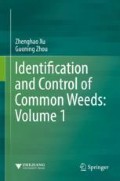Abstract
The Gramineae, also known as Poaceae, the fifth-largest plant family, in the order of Poales, is the family of monocotyledonous flowering plants, often referring to grasses, consisting of approximately 780 genera with around 12,000 species, with worldwide distribution. The grasses are chiefly annual or perennial herbaceous, rarely shrubby, but include some woody plants, such as cereals, bamboo, reeds, and sugarcane. However, seagrasses, rushes, and sedges fall outside this family. Roots in herbaceous are usually fibrous and fascicled, occasionally with stolons. Roots in woody bamboos or herbaceous grasses are often lignified, in bamboos with woody stolons. Stems or culms are jointed, hollow, or sometimes solid. Stems or branches are solitary or fascicled, subtended by sheaths in herbaceous plants. Leaves are alternate, two-ranked, often consisting of sheath, ligule, and blade, while blades are reduced in bamboos. Sheaths are usually with free margins, ligules borne at the mouth of the sheath, membranous or a rim of hairs. Leaf blades are divergent, mostly elongate, flat, convolute or terete, parallel-veined, or sometimes reticulately veined, especially in bamboos. Inflorescence is terminal or axillary, spicate, racemose or paniculate or digitate, occasionally solitary. Spikelets are usually with a shortened axis, rachilla, and two to many scales, while in bamboo spikelets are often complex clustered. The two lowest scales, glumes, are usually empty, while the following scales, lemmas, are bearing in their axil, a usually enclosed prophyll, palea, and a perfect or reduced flower. Lemma, palea, and flower are together forming the floret. Stamens are one to six, usually three, while there are more in bamboos. Pistil one. Filaments capillary. Anthers versatile. Ovary superior, one-loculed. Ovule one, anatropous. Styles are one to three and usually two. Stigmas are feathery. Fruit is a caryopsis, indehiscent, pericarp adherent seed stablely. Endosperm is usually copious. Embryo is small or large, dorsally at base. Hilium is punctate to linear. One hundred twenty-six grass species, mostly weeds, belonging to 74 different genera, are illustrated in the chapter.
Access this chapter
Tax calculation will be finalised at checkout
Purchases are for personal use only
Author information
Authors and Affiliations
Rights and permissions
Copyright information
© 2017 Zhejiang University Press, Hangzhou and Springer Science+Business Media Dordrecht
About this chapter
Cite this chapter
Xu, Z., Zhou, G. (2017). Gramineae. In: Identification and Control of Common Weeds: Volume 1. Springer, Dordrecht. https://doi.org/10.1007/978-94-024-0954-3_1
Download citation
DOI: https://doi.org/10.1007/978-94-024-0954-3_1
Published:
Publisher Name: Springer, Dordrecht
Print ISBN: 978-94-024-0952-9
Online ISBN: 978-94-024-0954-3
eBook Packages: Biomedical and Life SciencesBiomedical and Life Sciences (R0)

